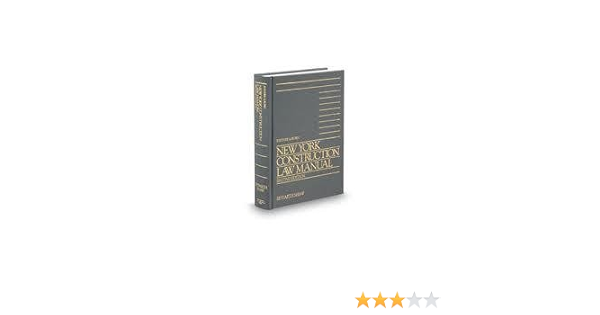(Learn more) A practical manual for attorneys, contractors, architects, engineers, and developers, New York Construction Law Manual covers virtually every legal issue involved in building structures in New York state. The New York courts broadly interpret “owners” to provide protection for the class of workers protected under Labor Law § 240(1). Owners in fee of land and title or record owners, including owners who lease their property are subject to liability under Labor Law § 240(1). 2020 Construction Law Compendium. This 2020 Compendium, prepared by the ALFA International Construction Practice Group members and edited by Jay Lea and David LeBas from Naman Howell Smith & Lee, PLLC, was designed to serve as a single resource for ALFAI clients regarding important construction law issues. New York Construction Law Manual by Robert Rubin Sarah Biser Catherine Brown A copy that has been read, but remains in excellent condition. Pages are intact and are not marred by notes.


Please join us on Wednesday, May 2, 2007 for a breakfast briefing featuring the newly revised New York Construction Law Manual, 2nd Edition, co-authored by Bob Rubin and Sarah Biser.

As a result of a new appellate court decision, New York employers may now face liquidated damages for failing to pay employees as frequently as required by the New York Labor Law. In a recent unexpected decision that departs from the conventional wisdom and older precedent, the Appellate Division of the New York Supreme Court for the First Department, in Vega v. CM & Associates Construction Management, LLC, held that “manual workers” who were paid in full, but paid on a biweekly or later basis, could recover liquidated damages for the employer’s failure to pay them weekly as required by state law. This decision could have significant implications for employers in New York.
New York’s Requirements Regarding Frequency of Pay for Manual Workers
State law requires employers to pay “manual workers” no less frequently than on a weekly basis.1 A manual worker is defined in the applicable statute as “a mechanic, workingman or laborer.”2 Notwithstanding this seemingly narrow definition, the New York State Department of Labor (NYSDOL) has broadly interpreted “manual worker” to include individuals who spend 25% or more of their working time engaged in physical labor.3 “Physical labor,” according to the NYSDOL, includes “countless physical tasks” and is not limited to heavy lifting. Thus, the NYSDOL has opined that employees, such as hairdressers, whose work encompassed only ancillary physical activities, are manual workers and therefore must be paid no less frequently than weekly.4
Older Precedent and Recent Litigation Regarding New York’s Frequency of Pay Law
It has long been the conventional wisdom, backed by uniform court precedent, that the remedy for violations of New York’s “frequency of pay” requirements is the NYSDOL’s imposition of civil penalties,5 and employers that pay their manual worker employees in full, but on a bi-weekly or later basis instead of on a weekly basis, were thought to be subject only to these NYSDOL penalties.6
More recently, however, private litigants have found more success in bringing civil lawsuits under New York’s weekly pay requirement where employees were paid in full, but paid less frequently. In these lawsuits, employees have sought to recover liquidated damages and interest on wages paid late, plus attorneys’ fees and costs associated with bringing the action. The respective federal and state courts, ruling on the employers’ motions to dismiss, have disagreed on whether New York’s weekly pay requirement provides a private right of action.7
Vega, Appellate Division, First Department Decision

In its September 10, 2019 decision, the panel of five justices of the First Department unanimously affirmed a lower court’s holding that New York’s weekly pay requirement does provide employees a private right of action.8 The First Department held liquidated damages could be recovered where an employee is paid in full, but paid late.9
Implications
Given the uncertainty in this area of law and its significance to employers and employees, the First Department’s decision might be appealed to the New York Court of Appeals. However, the six-year statute of limitations on New York Labor Law claims may result in substantial liability for employers, which would be well-advised to review and perhaps revise their pay frequency practices, particularly considering the NYSDOL’s broad interpretation of the “manual workers” who may be covered by the weekly pay requirement.
See Footnotes
2See New York Lab. Law § 190(4).
3See NYSDOL Op. Ltr. RO-09-0066 (May 21, 2009) (“It has been this Department's longstanding interpretation of the term 'manual workers' that the term includes employees who spend more than 25 percent of their working time performing physical labor.”).
4See NYSDOL Op. Ltr. RO-08-0061 (Dec. 4, 2008) ('Hairdressers cut and style hair. However, the general job duties of a hairdresser, in addition to cutting, coloring, and styling hair could also involve washing hair, cleaning the hairdresser's own work stations, and cleaning wash sinks, equipment, and other shared work spaces in the salon. Since the cutting and styling of hair, along with any of these other tasks, necessarily involves physical labor, such employees would be considered manual workers.')
5 Specifically, the New York Labor Law provides, “Where the violation is for a reason other than the employer's failure to pay wages . . . the order shall direct payment to the [NYSDOL] of a civil penalty in an amount not to exceed one thousand dollars for the first violation, two thousand dollars for a second violation or three thousand dollars for a third or subsequent violation.” New York Lab. Law § 218.

6See, e.g., Hussain v. Pak. Int’l Airlines Corp., No. 11-CV-932, 2012 U.S. Dist. LEXIS 152254, at *8 (E.D.N.Y. Oct. 23, 2012) (dismissing frequency of pay claim because “[the New York Labor Law] contains no provision for private recovery for violations of its provisions regarding frequency of pay…”).
Rubin And Rubin Law Firm
7See, e.g., Vega v. CM & Assoc., Constr. Mgt. Ltd. Liab. Co., 2018 N.Y. Misc LEXIS 1921 (Sup. Ct., Bronx Co., May 14, 2018) (denying employer’s motion to dismiss and holding there is a private right of action); No. 18-CV-0086, 2019 U.S. Dist. LEXIS 61726 (E.D.N.Y. Apr. 9, 2019) (same); c.f., Gardner v. D&D Electrical Construction Co. Inc, 2019 N.Y. Misc. LEXIS 4448 (Sup. Ct., New York Co., Aug. 7, 2019) (granting employer’s motion to dismiss and holding there is no private right of action); Hunter v. Planned Bldg. Servs., Inc., 2018 N.Y. Misc. LEXIS 2896 (Sup. Ct., Queens Co., June 11, 2018) (same).
David Rubin New York Times
8SeeVega v. CM & Assoc. Constr. Mgt., LLC, 2019 N.Y. App. Div. LEXIS 6464, 2019 NY Slip OP 06549 (Sept. 10, 2019). The First Department has jurisdiction over New York and Bronx counties.
The Rubin Law Firm Ny
9 The Plaintiff in Vega additionally sought to recover interest and reasonable attorney’s fees. The First Department did not expressly address this issue, but its holding that liquidated damages are available implies that interest and reasonable attorney’s fees also may be awarded under the statute.